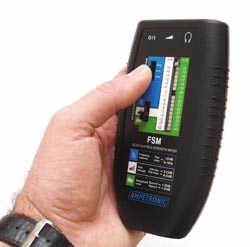- While there is no doubt that assistive listening systems (ALS) products can provide a useful 'value add' for contractors, such systems carry with them a number of practical issues which need to be borne in mind before, during, and after the installation process.
Ampetronic's new Field
Chad Engel of Williams Sound, which manufactures ALS products using both infrared (IR) and frequency modulation (FM) technology, believes the first priority for the installer is to consider the environment in which the system is to be installed.
"If the facility is located in a downtown or highly developed community, there may be too much interference from radio stations, fire stations, pagers, and so forth to run FM equipment," Engel said. "In these cases, infrared should be considered, because it is less susceptible to FM interference. If ballast lighting is installed in the facility, then the installer should specify an infrared system operating on 2.3-3.8MHz (95kHz infrared systems are known to be more problematic where ballast lighting is present).
"If security or discreet listening is a priority, then infrared is also preferable, because the infrared 'beam' will not pass through the opaque walls of a room where it could be intercepted by outside parties-which is the case with FM. For government installations, courtrooms, and so on, infrared is a good solution.
"With that said, infrared is still line-of-sight, so the audio can drop out if care isn't taken to have the transmitters positioned and pointed correctly. FM, on the other hand, will transmit indiscriminately throughout a facility for uninterrupted performance."
With the Americans with Disabilities Act (ADA) having laid down strict guidelines for the provision of hearing assistance in buildings, ALS equipment is being installed into a wider range of facilities than ever before. But, as Ken Hollands, commercial director for U.K.-based induction-loop manufacturer Ampetronic, points out, this can be a mixed blessing.

Induction loop installations, such as the Ampertronic install at Middlesex, must be tested to ensure precise performance.
One way to ensure that an installed system is performing as it should is to test it in accordance with an accepted industry standard. Julian Pieters, managing director of Ampetronic, said: "IEC60118-4 is the reference to which every induction loop installation should be tested. The new revision places more stringent and specific requirements on installers, as well as on facilities managers, to set up, commission, and maintain their loop systems."
Ampetronic believes that many installers are tempted to cut corners and not complete this testing properly, largely due to a lack of knowledge and the cost and complexity of test equipment. The company says it is tackling this issue through training courses and other tools and materials, and earlier this year it launched a new product, the IEC60118-4 Field Strength Meter (FSM). The FSM is intended to perform all the functions required for testing to the new standard, namely measuring background noise, field strength, and frequency response.
"The FSM is about a third of the price of a full analyzer and much simpler to use," Pieters added. "It does everything required and nothing more, making it hard to get things wrong, and making set up and commissioning fast and reliable. The meter should also be suitable, in terms of both cost and simplicity, for facilities managers to consider owning for regular checks on their system's performance.










